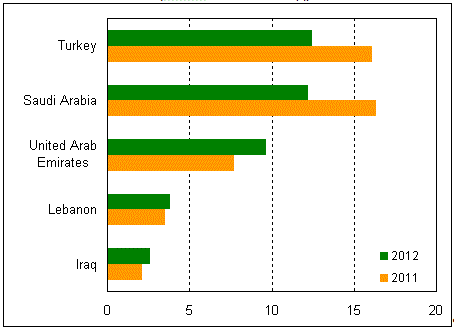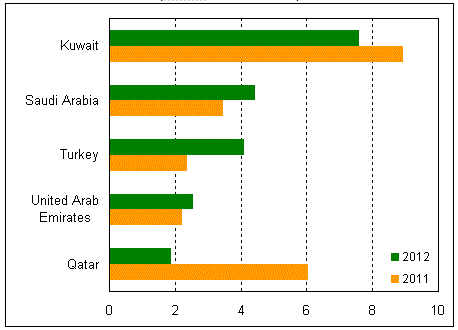Foreign direct investment (FDI) inflows to West Asia in 2012 continued a downturn turn that began in 2009, UNCTAD’s World Investment Report 20131 reveals. FDI to the region decreased by 4 per cent in 2012 to US$47 billion, half the level of 2008, the report says.
The report, which is subtitled Global Value Chains: Investment and Trade for Development, was released today.
Growing political uncertainty at the regional level and subdued economic prospects at the global level are holding back foreign investors’ propensity and capacity to invest in the region, the report says.
The overall figure hides important differences among countries, the study notes. A large fall in FDI flows was registered in the two main recipient countries – Turkey (down 23 per cent to $12.4 billion) and Saudi Arabia (down 25 per cent to $12.2 billion) (figure 1). However, FDI to these two countries still accounted for 52 per cent of the region’s total inflows. For the first time since 2006, Saudi Arabia ceded its position as the region’s largest recipient country to Turkey (figure 1).
Despite the strong decline registered in Saudi Arabia, FDI to Gulf Cooperation Council (GCC) countries as a whole remained at almost the same level in 2012 ($26 billion), because of significant FDI growth in all other countries within the group. FDI to the United Arab Emirates – the region’s third recipient country – increased by 25 per cent, to $9.6 billion, continuing a recovery initiated in 2010 but remaining below the level of $14 billion that was reached in 2007. High public spending by Abu Dhabi and a strong performance by Dubai’s non-hydrocarbon sectors helped rebuild foreign appetites for FDI in that country. Saudi Arabia and the United Arab Emirates alone accounted for 83 per cent of FDI inflows to the GCC economies. FDI to Kuwait more than doubled, reaching $1.9 billion, boosted by Qatar Telecom’s acquisition of additional shares in Kuwait’s second mobile operator Wataniya, which raised its stake to 92.1 per cent. FDI inflows also increased in Bahrain, Oman and Qatar, the report says.
FDI to non-GCC countries in the region declined by 9 per cent to $21 billion, due especially to the large drop in FDI to Turkey. Lower global growth and a prolonged fiscal tightening in the European Union – Turkey’s largest market – have reduced demand for Turkey’s exports, thus affecting export-led FDI, the report indicates.
However, most countries in the non-GCC group saw an increase in FDI inflows, the report reveals. This was the case for Iraq, where FDI in 2012 was up for the second consecutive year, increasing by 22 per cent to $2.6 billion, attracted by the country’s strong economic growth (8.4 per cent) which has been aided by significant increases in government spending. With its considerable hydrocarbon wealth, large population, and massive infrastructure investment needs, Iraq offers a wide range of opportunities for foreign investors, who are progressively investing despite the country’s political instability and security challenges, the report says.
Lebanon also registered positive FDI growth (9 per cent), enhanced by foreign acquisitions in the insurance industry and in services related to real estate.
FDI to Yemen swung back from a negative to a positive value in 2012 ($349 million), as investors were encouraged by the settlement of that country’s political crisis, while FDI to Jordan declined by 5 per cent, the report says.
Foreign investors, mainly those from developed countries, are reluctant to engage in the region, especially on large projects, the report notes. This has pushed some State-owned firms to move ahead alone on some key projects, for example the $4.6 billion Jizan refinery project in Saudi Arabia – originally planned as a joint venture between the State-owned Aramco and foreign firms – that was finally handed over to Aramco. Also going ahead is a $5.5 billion petrochemical project in Ras Laffan in Qatar, for which Qatar Petroleum chose its own unit over foreign giants as a partner. However 2012 also witnessed the start of some long-delayed or interrupted joint venture projects with foreign companies, such as the Sadara Chemical Company and the Yanbu refinery, both in Saudi Arabia.
Outward FDI from West Asia decreased by 9 per cent to $24 billion in 2012, putting a halt to the previous year’s recovery, the report notes. While GCC countries continued to account for most of the region’s outward FDI flows, Turkey emerged as a significant investor too (figure 2), with the amount of its outward investment growing by 74 per cent to a record $4.1 billion. This was mainly due to the $1.6 billion acquisition – by Anadolu Efes (Turkey) – of the Russian and Ukrainian beer businesses of SABMiller, the report says.
Figure 1. Top 5 recipients of FDI flows in West Asia, 2011 and 2012
(billions of US dollars)
Source: UNCTAD, World Investment Report 2013.
Figure 2. Top 5 investors from West Asia, 2011 and 2012
(billions of US dollars)
Source: UNCTAD, World Investment Report 2013.



